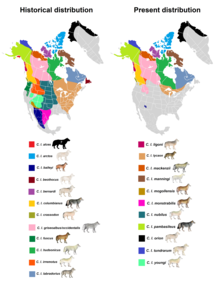| Arctic wolf | |
|---|---|

| |
| Scientific classification | |
| Domain: | Eukaryota |
| Kingdom: | Animalia |
| Phylum: | Chordata |
| Class: | Mammalia |
| Order: | Carnivora |
| Family: | Canidae |
| Genus: | Canis |
| Species: | |
| Subspecies: | C. l. arctos
|
| Trinomial name | |
| Canis lupus arctos Pocock, 1935
| |

| |
| Historical and present range of grey wolf subspecies in North America | |
The Arctic wolf (Canis lupus arctos), also known as the white wolf, polar wolf, and the Arctic grey wolf, is a subspecies of grey wolf native to the High Arctic tundra of Canada's Queen Elizabeth Islands, from Melville Island to Ellesmere Island.[3][4] Unlike some populations that move between tundra and forest regions,[5] Arctic wolves spend their entire lives north of the northern treeline.[6] Their distribution to south is limited to the northern fringes of the Middle Arctic tundra on the southern half of Prince of Wales and Somerset Islands.[4] It is a medium-sized subspecies, distinguished from the northwestern wolf by its smaller size, its whiter colouration, its narrower braincase,[7] and larger carnassials.[8] Since 1930, there has been a progressive reduction in size in Arctic wolf skulls, which is likely the result of wolf-dog hybridization.[8]
- ^ "Canadian Wildlife Species at Risk 2021". 2021-12-03. Retrieved 2023-10-14.
- ^ "Canis lupus arctos". Retrieved 2023-10-14.
- ^ Mech, L. David (1981), The Wolf: The Ecology and Behaviour of an Endangered Species, University of Minnesota Press, p. 352, ISBN 0-8166-1026-6
- ^ a b "Ecoregions 2017 ©". ecoregions.appspot.com.
- ^ "Wolves".
- ^ "Arctic Wolf Facts and Adaptations - Canis lupus arctos".
- ^ Goldman, E. A. (1964). Classification of wolves. In The Wolves of North America Part 2. Young, S. P. & Goldman, E. A. (Eds.) New York: Dover Publs. p. 430.
- ^ a b Clutton-Brock, J.; Kitchener, A. C.; Lynch, J. M. (1994). "Changes in the skull morphology of the Arctic wolf, Canis lupus arctos, during the twentieth century". Journal of Zoology. 233: 19–36. doi:10.1111/j.1469-7998.1994.tb05259.x.
